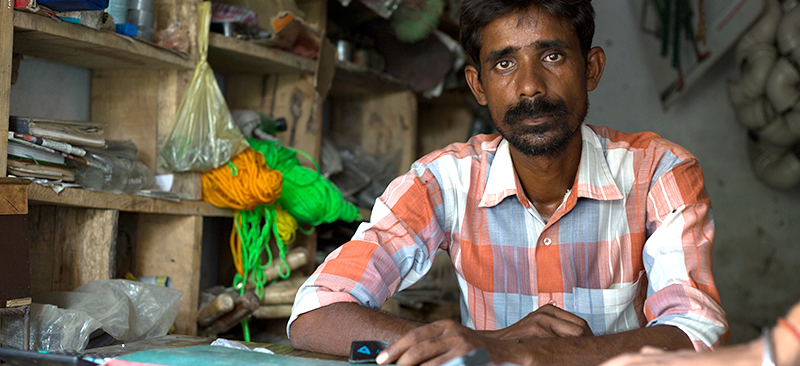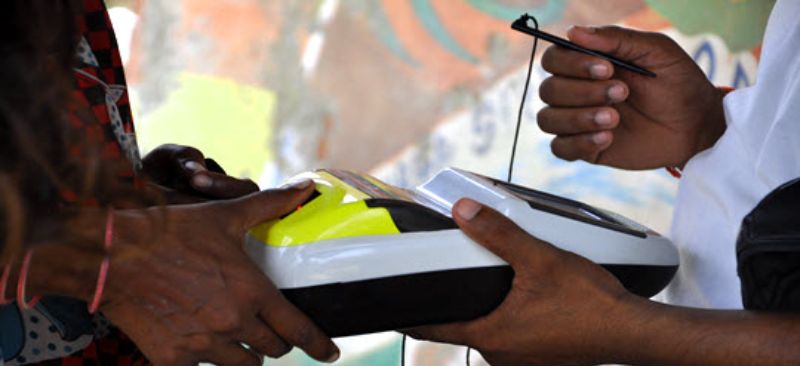In our previous blog, OTC Money Transfer in India: The Remittance Silver Bullet for Migrants, we explained how OTC remittances work in India, and described the typical transactional processes. In this blog, we map the customer’s experience (CX) while conducting OTC transactions. To understand the real experience of customers, MicroSavestaff posed as customers, visited agent outlets, and conducted OTC transactions using a mystery shopping tool. As explained in the previous blog, almost all transactions are P2B (person to bank); hence, mystery shopping was conducted only at origin point of remittances (in Delhi and Mumbai). While doing so, we selected different sets of agents on the basis of following indicators:
- Marketing collateral, so as to cover agents working for different providers
- High and low customer footfall; and
- Working hours ― peak and off-peak hours.
This segmentation during mystery shopping helped us to experience varied customer service at different agent outlets, and thus map out commonalities in a typical OTC remittance transaction.
The Customer Experience Map
This map is a detailed representation of CX while using OTC services for conducting remittances. As visually represented, the overall journey of a customer using OTC services can be clearly segregated into four phases:
The enquiry phase is mostly triggered by the inherent NEED of the customer to remit funds back home (for family). Most customers who use OTC services have almost invariably used other formal or informal mechanisms of remittances, such as direct deposits (to beneficiary’s bank account) at a bank branch, money order services offered by post office, hawala, and courier services, among others. These customers evaluate these alternatives before using OTC services using mental models/heuristics.
First-time users of OTC services are largely influenced by colleagues or relatives who have used the services before. These social groups act as key sources of information, especially for trial/first-time transactions. Customers primarily gather key information, such as agent location, charges, and ease/process of the transaction, before opting for such services. Thus, potential customers are indecisive and compare various alternatives for remitting funds at this stage.
Most providers have not adequately explored below-the-line (BTL) activities to communicate their service offerings to potential customers. They, instead, tend to rely on social proof, in the form of recommendations of friends and family who have used the service, as a mechanism for acquiring new customers. In the absence of BTL activities, awareness about OTC services is limited to a few users, who, in turn, are not able to influence potential users outside their social circles. Providers could benefit from enhanced BTL activities, as they are likely to scale-up the use of OTC services, given the direct correlation between awareness and trial. A larger number of customers using the service will also lead to more word-of-mouth marketing among customers satisfied with the service.
b. Trial Phase
Based on information gathered during the enquiry phase, customers graduate to a trial phase. It is during this phase that the customers transact for the first time. In most cases, the trial transaction is small – of around Rs.500―1,000 (US$7―15) ― as compared to regular fund transfer of Rs. 5,000―10,000 (US$70―1,500). This is done to understand the process, and develop trust, both in the agent and in the OTC channel. The agent outlet chosen to conduct the trial transaction is generally identified by referrals made by personal influencers and/or by collaterals displayed outside agent outlets. It is important to note that, initially, the choice of an agent outlet may be driven by socio-cultural factors, such as community and place of origin. However, customers soon start assessing various service aspects. During this phase, customers give much importance to the timeliness of the transaction process and service delivery (till completion of the transaction), as well as mandatory beneficiary details (these may include bank account number, IFSC code, branch name and address) and other documentation required.
This phase is critical for converting the trial customer into a long-term repeat customer. Not surprisingly, these customers, who are focused on the transactional aspect of remitting funds, are indifferent towards the underlying service providers. The agent, therefore, is the key actor, and plays a pivotal role in building positive experiences for customers, and facilitating their transition to the next phase, i.e., the transaction phase.
c. Transaction Phase
Even though there are typically many OTC providers at the sending end, most customers prefer transacting at specific agent outlets. This preference is an outcome of operational aspects such as reasonable customer charges (insofar as it is possible to assess this with the limited information available in the market), provision of receipts, success of previous transactions, and agent support, in case of any issue. Customers, in this phase, learn to trust and eventually rely on the channel, and are confident while using OTC services to remit funds.
As most agents register customers and open their wallets without the latter’s knowledge or consent, agents maintain customers’ records at the time of registration. When customers return, agents save considerable amounts of time by using the customer’s registered mobile number. A few providers have also enabled saving of receivers’ bank details and, thus, customers can simply use their mobile number to conduct a transaction without any need to remember/share the receivers’ bank details again.
When customers find it difficult to visit their preferred agents, they transact at outlets that are either referred to by colleagues/friends, or which they identify from marketing collateral at the outlets. Most often, customers recognise the logos of well-established banks (particularly State Bank of India) and are drawn to agent outlets that have these logos.
d. Repeat Transaction Phase
Most senders, who are typically either illiterate or semi-literate migrants, are daily wage earners. Hence, their preference for any channel (including agent outlets as well) has a direct relationship with the opportunity cost of using the channel. It is important to note that customers prefer OTC services because it requires little time (particularly as compared to banks, where waiting time is a major concern) and easier/minimal follow-up (as agents are commonly located near their places of work).
Hence, to build trust in the channel, it is essential to communicate the status of the transaction to customers on a near real-time basis at each step of the transaction. This is because customers are either unaware about any grievance redressal mechanism or believe that they have only one touch point, i.e., the agent. Most OTC providers already have a system in place to send SMS communication to their customers to inform them of the status of their transactions. This is very important for the sender, as this allows him to direct the recipient to withdraw funds from the appropriate cash-out point. Such communication assures senders about the success of the transaction and, if done correctly, almost ensures repeat transactions.
Since it is clear that repeat customers attach more importance to SMS communication than receipts provided by agents, providers should develop a system of SMS communications for both the sender and receiver throughout the different stages of transactions. This will include communication about the success or failure of a transaction, addition of recipient, etc.
Providers seldom put much emphasis on CX, focusing instead on incentivising agents to use their channel, thereby driving throughput. Since customers are indifferent to the underlying channels, it is difficult for providers to realise (and leverage) the advantage of customer stickiness without an agent incentives-based strategy. As we have seen in Pakistan (and was increasingly common in India until the recent strategic coopetition between the leading providers) this can lead to commission wars, with providers competing to pay the most attractive commissions. Ultimately, providers will want customers to insist on transactions being conducted through their channels. This will require differentiation that is clear to, and valued by, the customer.
In addition to building efficient SMS communications to allow customers to track their transactions, providers seeking to create a loyal customer base will need to look at other means to differentiate their services. In order to differentiate the channel adequately and make customers request specific services, providers may have to emphasise the other understated aspects of their delivery. These can include features such as real-time confirmatory messages via SMS, or transparency in pricing in the form of updated rate charts at agent outlets, and unambiguous voice based or text communication on charges to customers. Providers can also differentiate their services by ensuring that their systems are stable and reliable, thus minimising failure rates. Providers should also look to minimise agent-driven service denial by ensuring that the agents are well trained and compliant with organisational policies on liquidity and customer service. Finally, they can also enhance CX by educating and assisting potential customers to conduct trial transaction(s).
New entrants to the remittance space, such as payment banks and other money transfer operators, would benefit from a well-designed customer-centric approach that differentiates their service by optimising CX. Existing players, too, can start redefining their businesses by giving equal importance to CX and ensuring that their services become more attractive and efficient for their customers as well as agents, and thus build trust. For agents, interest and motivation are mainly driven by factors such as higher commission, ease of the transaction process, and timely provider support. OTC users, as noted above, choose agents instead of providers. Nonetheless, sub-optimal customer service is clearly affecting customer experience, which in turn reduces their trust and thus the uptake and usage of these services. It is, therefore, in the interest of providers to focus on both agents and customers. Focusing on delivering a positive customer experience at any touch point can act as a key differentiator for service providers in a keenly contested market space.





